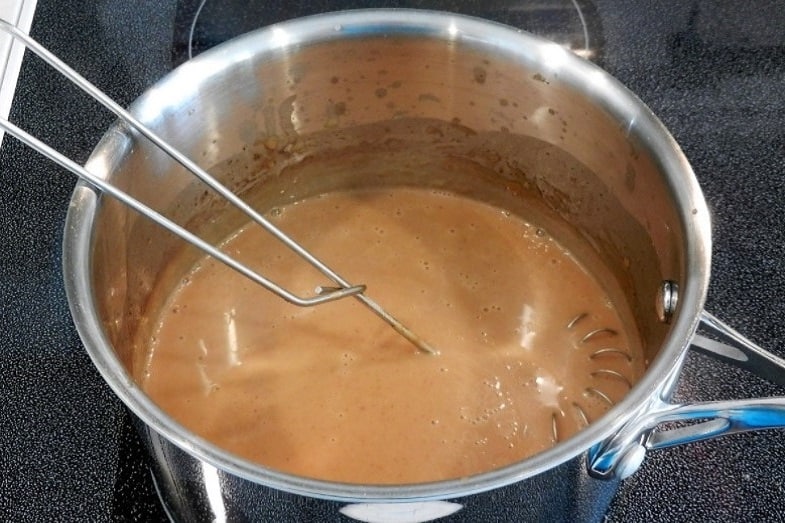How to make gravy without flour? Gravy is traditionally made with wheat flour as its thickener. But some people with health issues may not be allowed to consume flour. The good news is that you can make gravy without using flour.
How to make flourless gravy? To make gravy without flour, you can substitute the flour with cornstarch, potato starch, tapioca starch, or arrowroot powder. Any of these substitutes work well as thickening agents to your gravy.
In most gravy recipes, flour is used as a thickening agent. Flour works well because it is tasteless, inexpensive, and doesn’t get lumpy. But, if you need to make gravy without flour, there are other alternatives to this thickening agent.
6 ways to make gravy without flour are as follows:
- Cornstarch
- Potato Starch
- Tapioca
- Arrowroot
- Pureed Vegetables
- Reduce
Read on to learn more about how to make gravy without flour, including easy, flourless gravy recipes.
How to Make Gravy Without Flour
6 of the best alternatives to using traditional wheat flour in gravy are as follows:
1. Cornstarch
Substitute flour with cornstarch. Cornstarch, sometimes called cornflour, is a carbohydrate extracted from the endosperm of corn. Try using a little less amount than you would for flour as cornstarch makes sauces and gravy thicker than flour.
2. Potato Starch
Substitute potato starch for the flour. It is starch taken from potatoes and is also gluten-free. Add 1 part water to 2 parts potato starch and then mix into your gravy ingredients.
3. Tapioca
Substitute flour with tapioca. Tapioca is a starch taken from the cassava plant. It’s a good thickening agent for sauces. Follow any given recipe for gravy and substitute this for flour.
4. Arrowroot
Substitute arrowroot for the flour. Arrowroot is a starch taken from tropical plants that belong to the Marantaceae family. It is gluten-free and will work well to thicken the gravy. Mix equal parts water and arrowroot, and then whisk in with your other ingredients.
5. Pureed Vegetables
Substitute pureed vegetables for the flour. You can use many vegetables to thicken the gravy. Make a puree of potatoes, beets, and carrots. Next, incorporate pureed veggies into your gravy to thicken it. But remember, vegetables have their own taste, so the gravy will have a distinct taste of the vegetables you use.
6. Reduce
Reduce, reduce, reduce. Bring the liquid with drippings in a skillet and keep stirring with a wooden spoon. You’ll end up with a gravy that’s not runny but not really thick either. Gravy cooked this way is also called a glaze. You pour it on top of your meat.

Thickening Gravy with Various Starches
If you can’t have wheat or are on a gluten-free diet, it’s not a reason to skip gravy altogether. As previously mentioned, you can make gravy without flour by substituting starches for it.
Cornstarch, potato starch, tapioca starch, and arrowroot starch may all be used in place of flour to thicken the gravy. They must all be mixed with a small amount of cold tap water to create a slurry.
How to Use Starches to Thicken Gravy
Put your drippings in a saucepan. If you want a smoother gravy, strain your drippings (I am personally okay with a rougher gravy, so I do not strain mine). You may add chicken or beef stock or just water.
Bring the mixture to a simmer on a stovetop. Stir in or whisk in your starch slurry slowly. Simmer until it is thick enough to your desired consistency. For every cup of liquid that you use, you will need a small amount of starch slurry.
Use the following for every cup of liquid:
- Cornstarch – 1 tablespoon
- Potato starch – 1.5 teaspoons
- Tapioca starch –1.5 teaspoons
- Arrowroot starch – 1.5 teaspoons
Usually, potato starch and cornstarch work best when it comes to making gravy. They do not get all lumpy or stringy like tapioca starch or arrowroot starch. When you’re working with starches for gravy, it requires less simmering time. Just let it reach a boiling point and then turn off the heat. Do not over boil it to avoid losing its thickness.
Gravy made with cornstarch is usually clearer than gravy made with potato starch. If you’re making gravy with any starch, they won’t last as long as gravy made with flour in the refrigerator or freezer. It would be best to make what you can only consume for the time being.
Now we know how to make gravy without flour by using substitutes; next, let’s look at some flourless gravy recipes.
Does Popeyes Blackened Ranch Have Carbs?
Some Recipes of Gravy Without Flour
How exactly do you make gravy without flour? Here are some recipes to follow in making gravy without flour.
1. All Time Basic Gravy sans Flour
This gravy recipe is good for mashed potatoes and fried or grilled meats. It is quick and easy to make. Moreover, it is a light gravy that isn’t overpowering, so the taste of your meat will still come through.
You will need:
- ½ cup chicken or beef stock
- ¼ of an onion minced
- 1 tablespoon butter (optional)
- ¼ cup wine (optional; but if you take this out, add ¼ cup more of the broth)
- Salt and pepper to taste
- ¼ teaspoon lemon or lime juice (optional)
Procedure:
- After frying your meat, use about a teaspoon of the oil for your gravy, or you may use the same pan if it isn’t too darkened from the frying.
- Cook the onions in the wine (if you took out the wine, replace it with the stock). Then cook it over medium heat.
- Keep stirring until the onions become soft and the liquid has evaporated.
- Add the rest of the stock and keep stirring.
- When it has reduced to about 1/3 cup of liquid, turn off the heat and add the butter. Keep stirring until the butter is well mixed.
- Add the lemon or lime juice.
- Sprinkle with salt and pepper to taste.
- Pour over your meat or potatoes, or serve it separately on a gravy dish.
2. Gluten-free Gravy
This gravy recipe is best for people with celiac disease. It is gluten-free and is easy on the stomach. It works best for pan-fried chicken or fowl. You can actually tweak this recipe and add more herbs and spices to make it tastier. Store this gravy in the refrigerator for up to three days or in the freezer for two weeks.
You will need:
- 5 tablespoons turkey or chicken fat
- 4 tablespoons cornstarch or 6 tablespoons potato starch
- 4 cups chicken stock or turkey stock (either homemade or store-bought)
- 2 tablespoons butter (optional; you may use dairy-free butter if you prefer)
- Salt and pepper to taste

Procedure:
- Make your gluten-free roux by placing the fat in a saucepan over medium to low heat on the stovetop. Mix in either your cornstarch or potato starch. Your fat will quickly become very thick and then turn into a bubbling, creamy paste. Whisk it continuously until it becomes golden brown. This step is quick–somewhere between 3 to 4 minutes.
- Pour in just about a cup of stock. Continue whisking until the roux incorporates into the stock, and it becomes smoother. Add in the remaining stock slowly. Continue cooking over low heat until it forms heat bubbles and thickens. This step will take around 5 minutes.
- Now you may season your gravy with salt and pepper to taste. It would be best if you use freshly ground pepper. You may serve it in a gravy dish topped with some spring onions or celery.
3. Tapioca / Arrowroot Gravy
This gravy works well with roasts. It uses tapioca or arrowroot, which is also a gluten-free thickener. So, people on a gluten-free diet can make this. It is quick and easy to make but tastes so rich and flavorful!
You will need:
- 1 tablespoon tapioca starch or arrowroot powder
- 4 tablespoons coconut oil or melted butter
- 2 ½ cups chicken or turkey stock or drippings
- ½ teaspoon garlic powder (optional)
- ¼ teaspoon salt
- Fresh ground pepper to taste
Procedure:
- Place your fat in a saucepan over low heat. After melting it, add your tapioca starch or arrowroot starch. Whisk it very well to smoothen all the lumpy parts. Cook until golden and bubbling. This step will take about a minute only.
- Pour in your stock slowly while you continue to whisk. It may still remain lumpy at this point but keep whisking, and it will smoothen out.
- Over low heat, keep whisking until it thickens. This step will be about 2 to 3 minutes. Add your garlic powder. Whisk it again to get any more lumps left.
- Season with salt and pepper.
- Serve over your meat or in a gravy dish.
Note: Tapioca and arrowroot starches tend to be lumpier than the other starches. If the lumps are still there after cooking your gravy, use a strainer to remove them.
Various Types of Gravy
Gravy is a type of sauce cooked from meat drippings of chicken, pork, turkey, or beef with the addition of flour, herbs, and spices. It is an excellent addition to so many dishes! Fried chicken, roast turkey, mashed potatoes, shepherd’s pie, and meatballs are some of the foods that go really well with gravy.
Gravy gives life and flavor to an otherwise bland or plain dish. The truth is, you can never have too much gravy. You can actually cook up a whole batch and then freeze it so that it will last for months.
Below are 5 different types of gravy. You can make each without flour. Simply substitute the flour with the options mentioned earlier to try any of these great gravies.
1. Brown Gravy
This gravy is the most common type. It is made from drippings of meat. On a stovetop, the drippings are cooked with flavor enhancers, such as onions, herbs, and spices. It is thickened using wheat flour or cornstarch until it reaches the desired texture.
2. Cream Gravy
This kind of gravy goes well with biscuits or steaks. You make it starting with a roux (a mixture of flour and fat cooked together) and meat drippings. Milk is added and gets thickened by the roux. Some people add chicken liver, black pepper, and even chopped-up sausage. Other terms for this gravy are milk gravy and country gravy.
3. Egg Gravy
This gravy is made with meat drippings and a thick roux. With this mixture, you add water or broth, and then salt and pepper to taste. When it is briskly boiling, add a well-beaten egg while stirring or whisking. The egg then separates into tiny pieces in the gravy.
4. Giblet Gravy
Giblets refer to the liver, heart, and gizzard of chicken or other fowl. They are added to the roux and drippings and are often used for chicken and fowl dishes. Also, these internal organs are removed before cooking the chicken.
5. Vegetable Gravy
Vegetarians use this type of gravy. It contains vegetable broth or stock and flour. Other ingredients added to this gravy are oil, butter, or margarine. You can also add wine to enhance its flavor.
So, all of these kinds of gravy are made with either wheat or cornflour for thickening. However, some people need gravy without flour either as a personal preference or for health reasons.
Conclusion – How to Make Gravy Without Flour
So, to recap, how to make gravy without flour? There are various substitutes for flour, including cornstarch, potato starch, tapioca starch, and arrowroot starch.
6 ways to make gravy without flour are as follows:
- Cornstarch
- Potato Starch
- Tapioca
- Arrowroot
- Pureed Vegetables
- Reduce
Follow this guide in making your flourless gravy. For every cup of liquid, use:
- Cornstarch – 1 tablespoon
- Potato starch – 1.5 teaspoons
- Tapioca starch -1.5 teaspoons
- Arrowroot starch – 1.5 teaspoons
Follow the suggested recipes above, and remember, if you’re someone who can’t have wheat flour in your diet, it isn’t a reason to give up having gravy in your food.
Read next:




![Read more about the article How Long to Boil Chicken Breast? [Boneless, Bone-In, and Frozen]](https://howchimp.com/wp-content/uploads/2020/10/how-long-to-boil-chicken-breast-300x200.jpg)